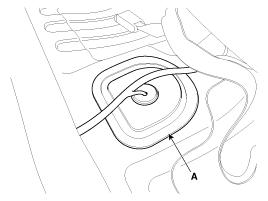Check motor operation by fuel pump connector (A) connecting power(No.2) and ground(No.4)

Pin No. | discription |
1 | Fuel sender signal |
2 | Fuel pump (+) |
3 | Fuel sender ground |
4 | Fuel pump (-) |
Turn ignition switch OFF and disconnect the battery negative (-) terminal.
Remove the fuel pump assembly.
Check motor operation by fuel pump connector (A) connecting power(No.2) and ground(No.4)

Pin No. | discription |
1 | Fuel sender signal |
2 | Fuel pump (+) |
3 | Fuel sender ground |
4 | Fuel pump (-) |
Turn ignition switch OFF and disconnect the battery negative (-) terminal.
Remove the fuel pump assembly.
Using an ohmmeter, measure the resistance between terminals 1 and 3 of sender connector (A) at each float level.

Pin No. | discription |
1 | Fuel sender signal |
2 | Fuel pump (+) |
3 | Fuel sender ground |
4 | Fuel pump (-) |
Also check that the resistance changes smoothly when the float is moved from "E" to "F".
Position | Resistance (Ω) | Capacity (ℓ) |
E | 197 ~ 203 | 3.0 |
1/2 | 64.2 ~ 68.2 | 24.6 |
F | 6 ~ 10 | 49.0 |
Release the residual pressure in fuel line (Refer to the Fuel Delivery System - Repair Procedures - "Release Residual Pressure in Fuel Line").
Remove the rear seat.
(Refer to Body - “Rear Seat Assembly”)
Remove the fuel pump service cover (A).

Disconnect the fuel pump connector (A).
Disconnect the fuel feed tube quick connector (B) and the vapor tube quick-connector (C).
Remove the plate cover (D) by loosening the mounting bolts.

Remove the fuel pump from the fuel tank.

Install in the reverse order of removal.
Be careful of fuel pump direction when installing (Refer to the groove in the fuel tank).
Fuel pump plate cover mounting bolt:
2.0 ~ 3.0 N.m (0.2 ~ 0.3 kgf.m, 1.4 ~ 2.2lb-ft)